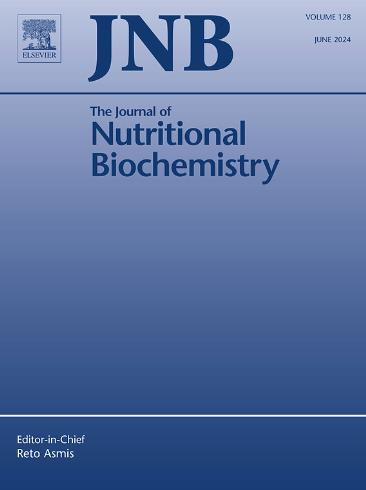异硫氰酸苯乙酯(PEITC)与Keap1相互作用激活Nrf2通路,抑制脂肪细胞中的脂质积累。
IF 4.8
2区 医学
Q1 BIOCHEMISTRY & MOLECULAR BIOLOGY
引用次数: 0
摘要
异硫氰酸苯乙酯(PEITC)因其对各种人类疾病的潜在影响而得到认可。然而,PEITC对脂肪细胞分化的影响及其潜在的分子机制尚不清楚。本研究探讨了PEITC对脂肪细胞分化的影响,并阐明了Nrf2激活的分子机制。在C3H10T1/2和3T3-L1细胞中观察PEITC对脂肪细胞分化的影响。PEITC在Nrf2敲除(KO) MEF和Keap1 KO H1299细胞中检测了Nrf2诱导的效应。通过热移实验和共免疫沉淀实验评估PEITC和Keap1之间的相互作用。在Keap1 KO细胞中重构Keap1的半胱氨酸突变体,以阐明petc诱导的Nrf2稳定的关键氨基酸。在C3H10T1/2和3T3-L1细胞中,PEITC抗脂肪生成作用的关键是脂肪形成的初始阶段。PEITC增加了Nrf2蛋白的表达,但在Keap1 KO细胞中没有这种诱导作用。用纯化的Keap1的BTB结构域进行热移实验证实了与PEITC的直接相互作用。Keap1在Keap1 KO细胞中的重新表达表明,151位的半胱氨酸残基对于petc诱导的Nrf2表达和Nrf2-Keap1复合物的破坏至关重要。研究发现,PEITC激活nrf2介导的基因表达,至少部分地通过nrf2依赖机制抑制脂肪细胞分化。本研究证实了PEITC的抗脂肪生成作用。机制研究表明,PEITC与Keap1相互作用,Keap1的半胱氨酸残基(C151)对PEITC对Nrf2激活的影响至关重要。本文章由计算机程序翻译,如有差异,请以英文原文为准。
Phenethyl Isothiocyanate (PEITC) interaction with Keap1 activates the Nrf2 pathway and inhibits lipid accumulation in adipocytes
Phenethyl isothiocyanate (PEITC) has been recognized for its potential effects in various human diseases. However, the impact of PEITC on adipocyte differentiation and its underlying molecular mechanisms is not well understood. This study investigates the effects of PEITC on adipocyte differentiation and elucidates the molecular mechanisms involved in Nrf2 activation. The effects of PEITC on adipocyte differentiation were assessed in C3H10T1/2 and 3T3-L1 cells. Nrf2-induced effects by PEITC were examined in Nrf2 knockout (KO) MEF and Keap1 KO H1299 cells. The interaction between PEITC and Keap1 was evaluated using thermal shift assays and Co-immunoprecipitation experiments. Reconstitution of cysteine mutants of Keap1 in Keap1 KO cells was used to elucidate a critical amino acid for the PEITC-induced Nrf2 stabilization. The initial stages of adipogenesis were crucial for PEITC's antiadipogenic effects in C3H10T1/2 and 3T3-L1 cells. PEITC increased Nrf2 protein expression, but this induction was absent in Keap1 KO cells. Thermal shift assays with the purified BTB domain of Keap1 confirmed a direct interaction with PEITC. Re-expression of Keap1 in Keap1 KO cells showed that the cysteine residue at position 151 is essential for PEITC-induced Nrf2 expression and the disruption of the Nrf2-Keap1 complex. PEITC was found to activate Nrf2-mediated gene expression and inhibit adipocyte differentiation, at least partially, through Nrf2-dependent mechanisms. This study confirms the antiadipogenic effects of PEITC. Mechanistic investigations demonstrate that PEITC interacts with Keap1 and that the cysteine residue (C151) of Keap1 is critical for PEITC's effects on Nrf2 activation.
求助全文
通过发布文献求助,成功后即可免费获取论文全文。
去求助
来源期刊

Journal of Nutritional Biochemistry
医学-生化与分子生物学
CiteScore
9.50
自引率
3.60%
发文量
237
审稿时长
68 days
期刊介绍:
Devoted to advancements in nutritional sciences, The Journal of Nutritional Biochemistry presents experimental nutrition research as it relates to: biochemistry, molecular biology, toxicology, or physiology.
Rigorous reviews by an international editorial board of distinguished scientists ensure publication of the most current and key research being conducted in nutrition at the cellular, animal and human level. In addition to its monthly features of critical reviews and research articles, The Journal of Nutritional Biochemistry also periodically publishes emerging issues, experimental methods, and other types of articles.
 求助内容:
求助内容: 应助结果提醒方式:
应助结果提醒方式:


